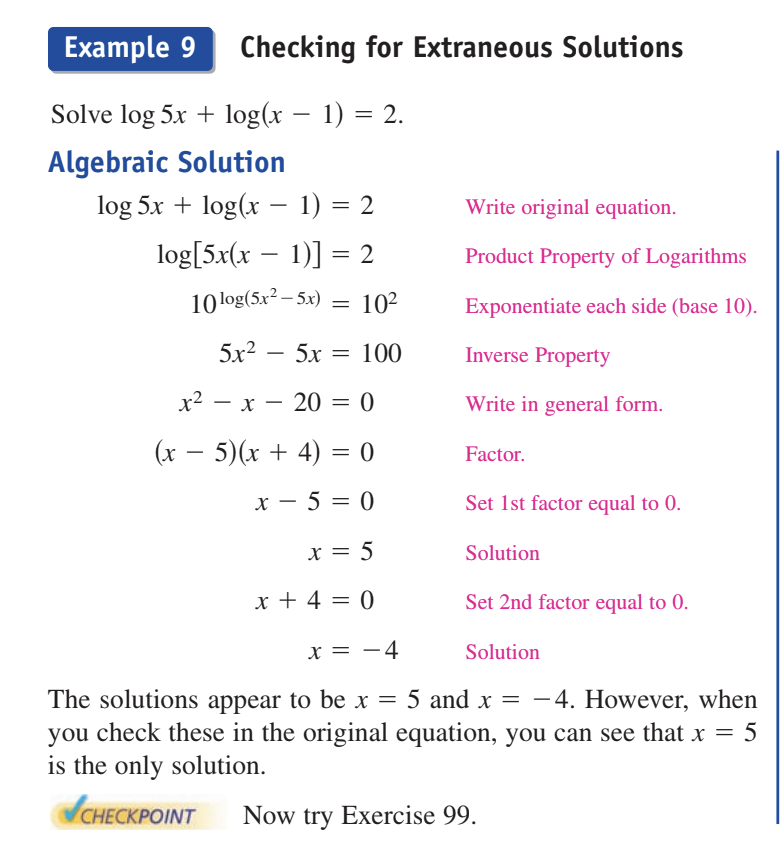Logarithm and Exponential Functions Unit 3 3.1-3.4
1/71
Earn XP
Description and Tags
Review but hard
Name | Mastery | Learn | Test | Matching | Spaced |
|---|
No study sessions yet.
72 Terms
Hw assignment
around page #245

BOLD TERMS ARE SUPER IMPORTANT BOLD+ ITALIZIZE MOST IMPORTANT
3.1 Exponential functions and there graphs
2 functions we will study in this chapter
exponential functions and logarithmic functions.
These functions are examples of transcendental functions.
Definition of an Exponential function
The exponential function F with base A is denoted by
f(x)= ax
where a>0, a≠1. and x is any real number
Why does base a have to be positive and cant be 0
Why the base a in f(x)=ax must be positive for logs and exponential functions
Problem with a negative base:
If a<0 then ax can become exponents under 1
Example: (−2)1/2 = sqaure root of -2 → not a real number
Positive base works for all real exponents:
Any positive number raised to a real number is always real and positive.
Example: 21/2 sqrt 2
Summary:
Positive base ensures the function is defined for every real x.
Negative base breaks the function for fractional or irrational exponents.
If f(x)=0x
For positive exponents (x>0):
0x=0
✅ This works fine.
For x = 0:
00 is undefined!
❌ There’s no universally agreed value for 0^0
For negative exponents x<0
0-1→ undefined!
a>0ensures the function is always positive
a≠1ensures the function actually changes with x
a≠0 avoids undefined values for negative and zero exponent
Evaluating Exponential Functions
a. f(x)=2x x=-3.1. just plug in on calculator get .1166291
Just use calculator enclose fractional exponents in parenthesis
Graphs of Exponential Functions
y=ax
sketch graph of F(x)=2x, G(x)=4x
List the values in a table for each function Note that both graphs are increasing. Moreover, the graph of is increasing more rapidly than the graph of
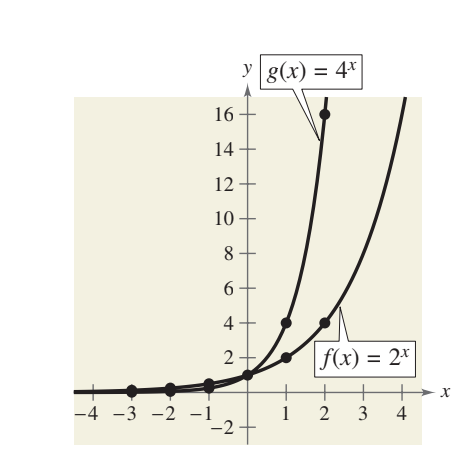
Graphs of Exponential Functions
y=a-x
sketch graph of F(x)=2-x, G(x)=4-x
List the values in a table for each function. Note that both graphs are decreasing. Moreover, g(x) is decreasing more rapidly than f(x)
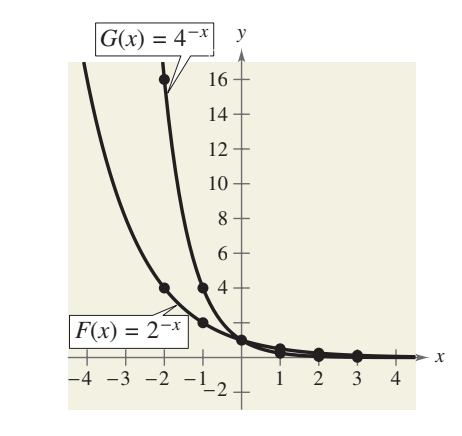
Comparing the 2 exponential functions
IMPORTANT
F(x)=2-x= f(-x) and G(x)=4-x = g(-x)
IT IS A REFLECTION OVER THE Y-axis
SUPER IMPORTANT
EXPONENTIAL FUNCTION GRAPHS OVERVIEW CHARACTERISTICS
range for both is (0,infinity) no negative range
FOR ALL EXPONENTIAL FUNCTIONS (0,1) ON IT
as x approaches negative infinity y approaches 0 from above for positive
as x approaches infinity y approaches infinity for positive
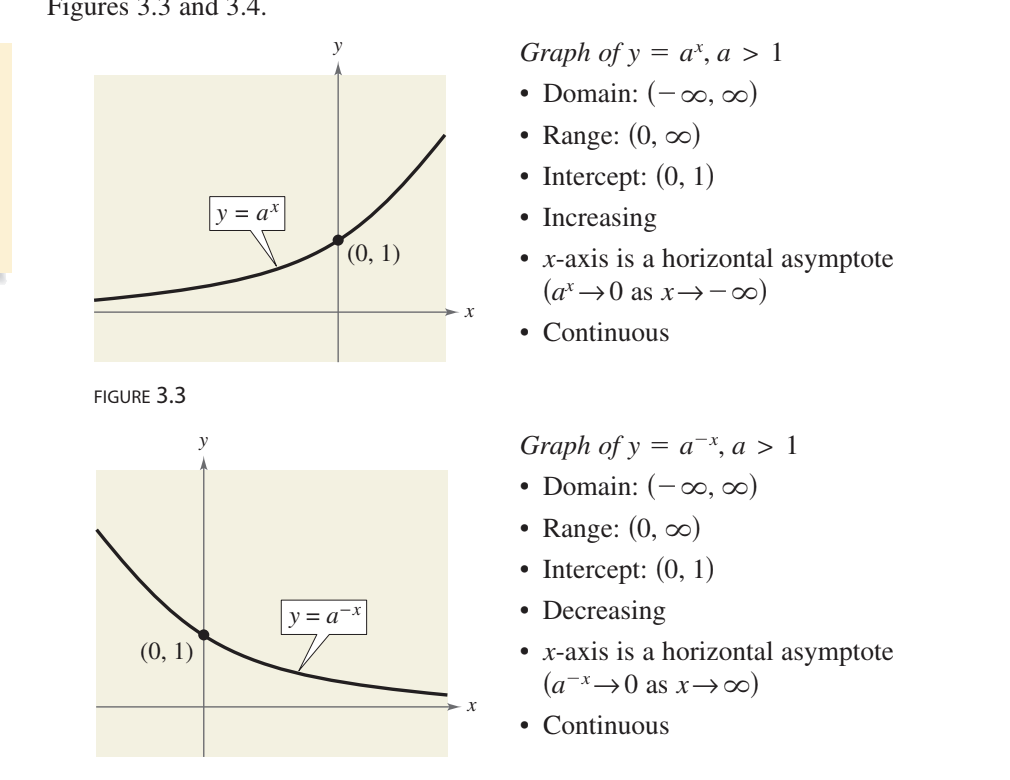
One-To- One property EXPONENTIAL FUNCTIONS
and examples
The graphs both pass the horizontal line test so ONE-TO-ONE functions
SO can use ONE-TO-ONE PROPERTY TO SOLVE SIMPLE EXPONENTIAL EQUATIONS
for a>0 and a≠1 , ax=ay if and only if x=y
EXAMPLE
9=3x+1 equals 32=3x+1 so x+1=2 so x=1
Transformations of EXPONENTIAL FUNCTIONS
Start with f(x)=3x
SAME AS ALL OTHER FUNCTIONS
Shift asymptote with it
Horizontal shift
g(x)=3x+1 = f(x+1) shift graph of f one unit to the left to get graph of g
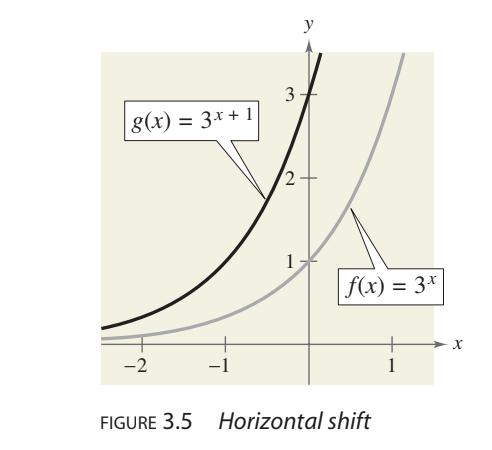
Vertical SHIFT
h(x)=3x-2 = f(x) -2 shift graph of f 2 units down to get graph of h
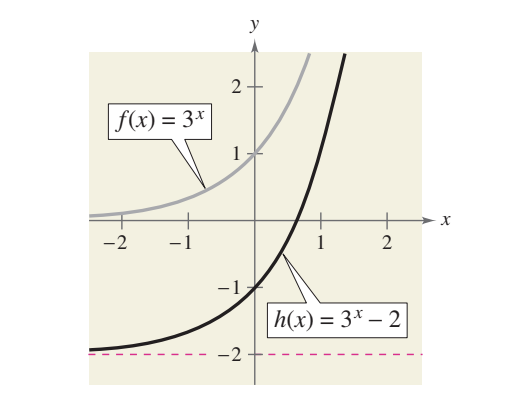
Reflection over x-axis
k(x)=-3x = -f(x) reflect f over x-axis to get graph of k

reflection over y-axis
j(x)=3-x= f(-x) reflect f over y-axis to get j
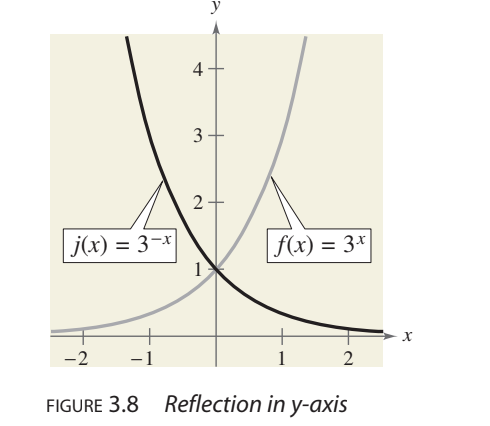
Other shifts like vertical stretch and shrink and horizontal stretch and shrink are same thing as normal
Natural Base E
e is called the natural base. function f(x)= ex called natural exponential function
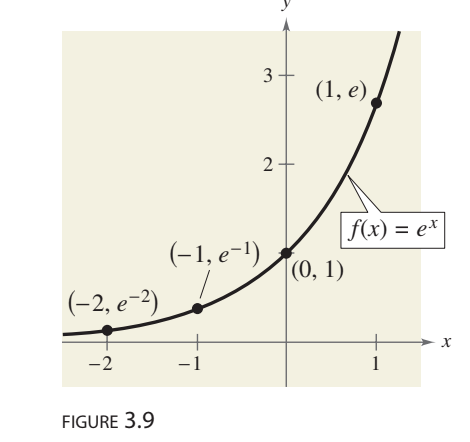
Evaluation natural Exponential Function
use calculator f(-2)=e-2 plug in on calculator get .13533
Graphing Natural Exponential Functions
Sketch the graph f(x)=2e.24x use graphing utility to plot points or
using what you know about exponential graph of y=ax know that as ax approaches 0 x approaches negative infinity and as y=ax approaches infinity x approaches infinity and know that the x intercept is (2,0) and graph it.
3.2 Log functions and there graphs
Domain of Exponential Functions
Domain: (−∞,∞)
Exponential functions are defined for all real numbers x.
Example: f(x)=2x→ any x works.
Negative exponents are allowed because of the rule:
a-x=1/ax
Range of Exponential Functions
Range: (0,∞)
The output is always positive, never zero or negative.
The horizontal asymptote is y=0
Because
For negative x-values: a-x=1/ax which is greater than 0
For positive x-values: ax>0
So, no matter what x is, f(x) is always greater than 0, never negative.
Intro what is LOG
that if a function is one-to-one—that is, if the function has the property that no h orizontal line intersects the graph of the function more than once—the function must have an inverse function.
By looking back at the graphs of the exponential functions introduced in Section 3.1, you will see that every function of the form y=ax passes the Horizontal Line Test and therefore must have an inverse function.
This inverse function is called the logarithmic function with base a.
Inverse function properties
as we know inverse means reflect over y=x and also to solve for x you switch x and y
Definition of Log function with base a
for x>0, a>0 and a≠1
y=logax if and only if x=ay
The function given by f(x)=logax called Log function with base a
Log form verus Exponential form
y=logax vs. x=ay
Ex 1. Evaluating logs
ex. f(x)= log2x x=32 = 5 because 25=32
Common Log function
The logarithmic function with base 10 is called the common logarithmic function. It is denoted by or simply by log.
VERY IMPORTANT PROPERTIES OF LOGS MOST

PROOF OF Logax+logay=logaxy
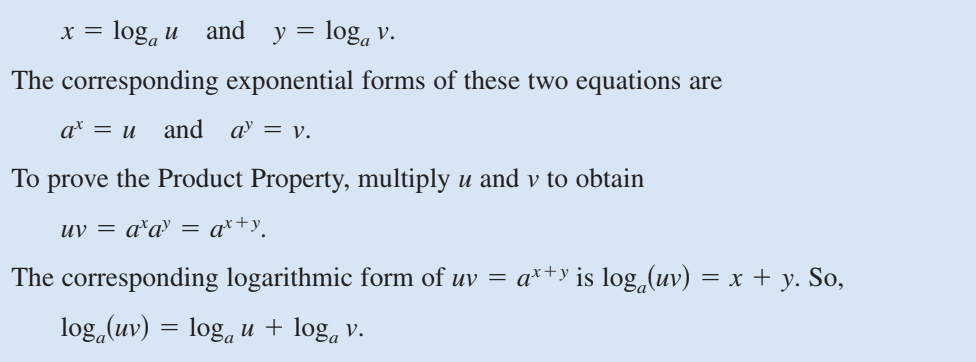
PROOF OF Logax-logay=loga(x/y)
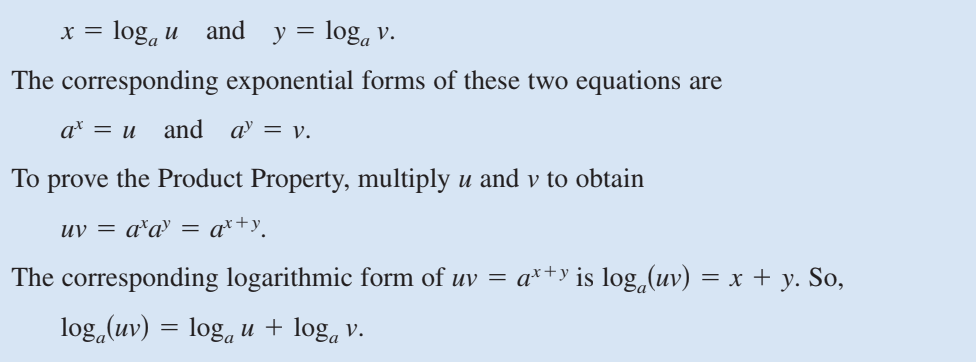
PROOF OF Logax2=2loga(x)
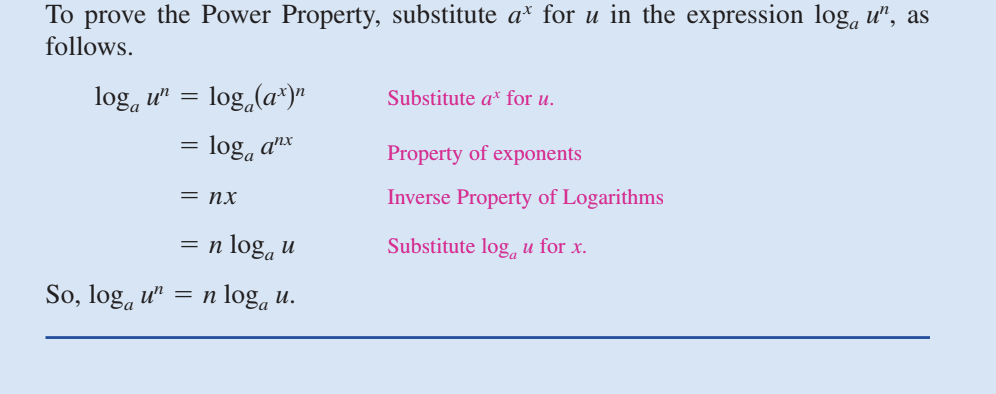
Example 3 using properties of Logs
ex. simplify log41. it is 0 using property 1
ex. simplify logroot7root7 it is 1 using property 2
Example 4 using one-to-one property
ex. log3x=log312 x=12
ex. log(2x+1)=log(x). x=-1
GRAPHS OF LOG FUNCTIONS
to sketch the graph of y=logax use fact that the graphs of inverse
functions are reflections of each other in the line y=x
Example 5 Graphs of Exp and LOG FUNCTIONS
f(x)=2x. g(x) y=log2(x)
For f(x) construct a table of values. By plotting these points and con-
necting them with a smooth curve
Because g(x) is the inverse function of the graph of f(x) graph of g obtained by plotting the opposite points of
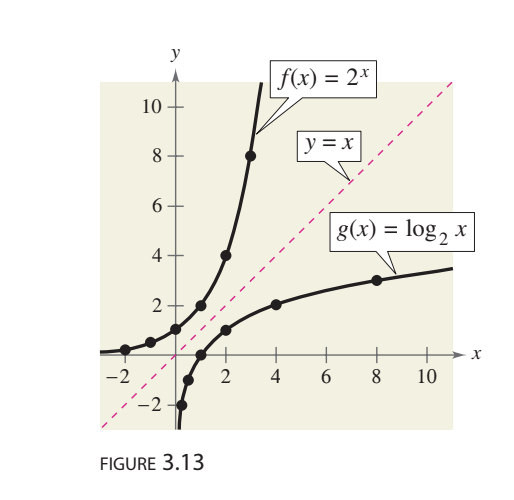
Example 6 Sketching the Graph of a Logarithmic Function
Sketch the graph of the common logarithmic function f(x)=log(x) Identify the vertical asymptote.
plot points in a table of values x=1 will always be 0
X- INTERCEPT FOR ALL LOG FUNCTION GRAPHS WITH NO TRANSFORMATIONS (1,0) then use knowledge like x=10 y=1 and x=1/10 y=-1
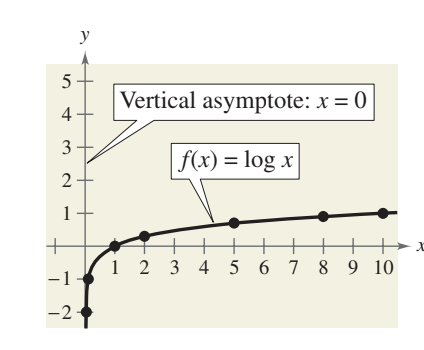
graph of y=loga(x) CHARACTERISTICS
as x approaches 0 from above y approaches negative infinity
as x approaches infinity y approaches infinity

TRANSFORMATIONS OF LOG FUNCTIONS
SAME AS EXPONENTIAL

Natural Log Function
natural exponential function f(x)=ex has an inverse called natural log
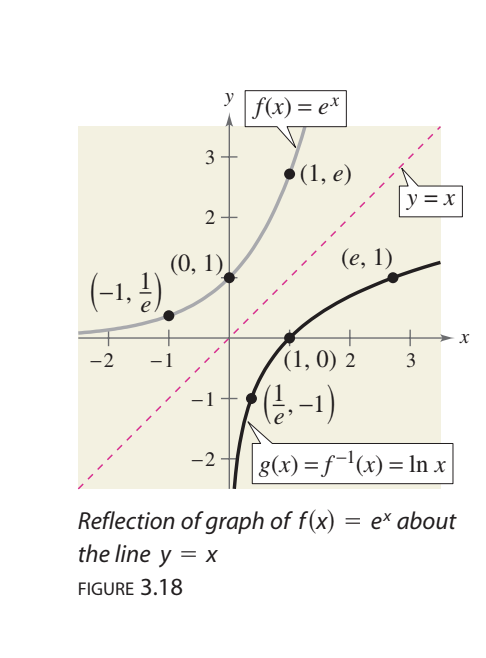
Natural log defined
f(x)=loge(x)=lnx, x>0
Properties of Natural logs SAME AS PROPERTIES OF LOGS

Domain OF LOG FUNCTIONS
Definition: loga(x)=y is ay=x
The exponential ay is always positive, so x must also be positive.
You cannot take the log of 0 or a negative number because there is no real number yyy that satisfies ay=0a^y = 0ay=0 or ay<0a^y < 0ay<0.
✅ Domain: (0,∞)
Range OF LOG FUNCTIONS
Logarithm outputs any real number because ay can take any positive number.
For any positive x, there is some y such that ay=x
This means y=loga(x) can be very negative, zero, or very positive.
✅ Range: (−∞,∞)
Finding domain’s example
h(x)=lnx2
it would be defined only if x2 is greater than 0
3.3 PROPERTIES OF LOGS
Change of Base
might need to evaluate logs of other bases than 10 and e so use change of Base formula

Example 1 Changing base using common logs
a. log425 = log(25)/log(4) and then use calc
b. log212 =log(12)/log(2) and then use calc
MOST IMPORTANT THING SO FAR
know that loga(x) is the inverse of the exponential function with base a so properties of exponents should have corresponding ones with logs.
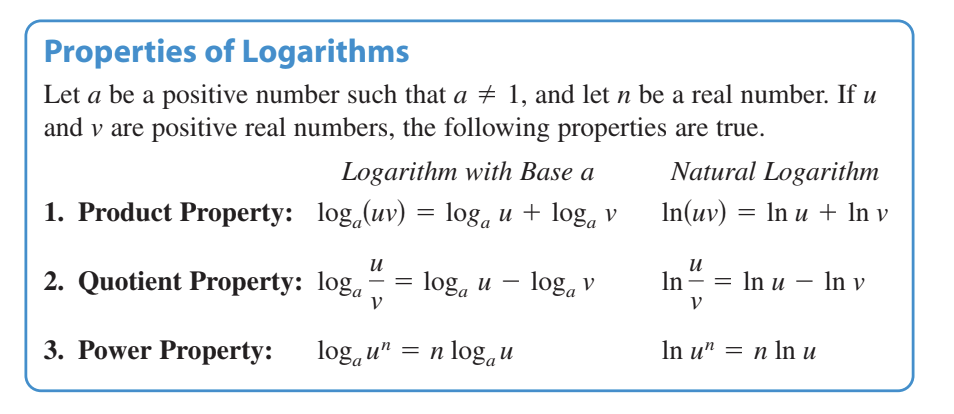
Example Using properties of Logs
log6 = log 2 + log 3
log5 cube root5 = log5 5 1/3 = 1/3
Rewriting Logarithmic Expressions
The properties of logarithms are useful for rewriting logarithmic expressions in forms that simplify the operations of algebra. This is true because these properties convert complicated products, quotients, and exponential forms into simpler sums, differences, and products, respectively.
Example 5 Expanding Log expressions
log45 x 3y- is log4(5)+3log4x+log4y
ln root (3x- 5)/7 is 1/2ln(3x-5) - ln(7)
Example 6 Condensing Log expressions
1/2log(x)+3 log(x+1)
log(root x (x+1)3 )
1/3 [log2x + log2(x+1)}
log2 cube root x(x+1)
3.4 Exponential and Log equations
So far in this chapter, have studied the definitions, graphs, and properties of exponential and logarithmic functions. In this section, you will study procedures for solving equations involving these exponential and logarithmic functions.
There are two basic strategies for solving exponential or logarithmic
equations.
The first is based on the One-to-One Properties and was used to solve
simple exponential and logarithmic equations in Sections 3.1 and 3.2
The second is based on the inverse properties. for a>0 the following
properties are true for all x and y for which logax and logay are defined.
One to one properties Solving equations
ax=ay IFF x=y
logax=logay IFF x=y
Inverse properties Solving equations
alogax=x
logaax=x
Example 1 Solving simple equations
2x=32. rewrite 2x=25. x=5 because of 1to 1
ex=7 ln ex= ln7. x=ln7 because of inverse
Strategies for Solving Exp and Log equations
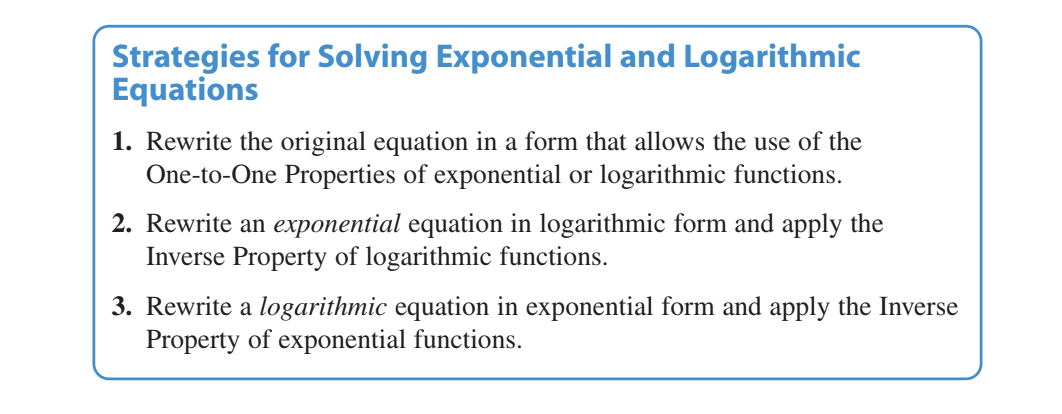
Example 2 Solving Exponential equations
e-xsquared = e-3x-4 use one to one and factor and get x=4 and x=-1
3(2x)=42 divide each side by 3 and then log2 both sides and get log214
Example 3 Solving an exponential Equation
ex+5=60 subtract 5 from both sides and then natural log both sides to get x = ln 55
2(32t-5)-4=11 add 4 to both sides and then divide both sides by 2 then log 3 both sides and then solve and get t=1/2 log3(15/2) + 5/2
Example 5 solving quadratic exponential equation

Solving Log equations
to solve a log equation, you can write it in exponetial form
1⃣ ln(x)=3
Exponentiate both sides (base e):
eln(x)=e3. ⇒x=e3
Exponentiating
Exponentiating means raising both sides of an equation to the base of the logarithm to “undo” the log.
It’s the inverse operation of taking a logarithm.
If
loga(x)=y then exponentiating gives
ay=x.
Why it works:
The logarithm and exponential functions are inverses:
alogax=x. and loga(ax)=x.
Examples:
1⃣ ln(x)=3
Exponentiate both sides (base e):
eln(x)=e33 ⇒x=e3
Example 6 Solving Log equations
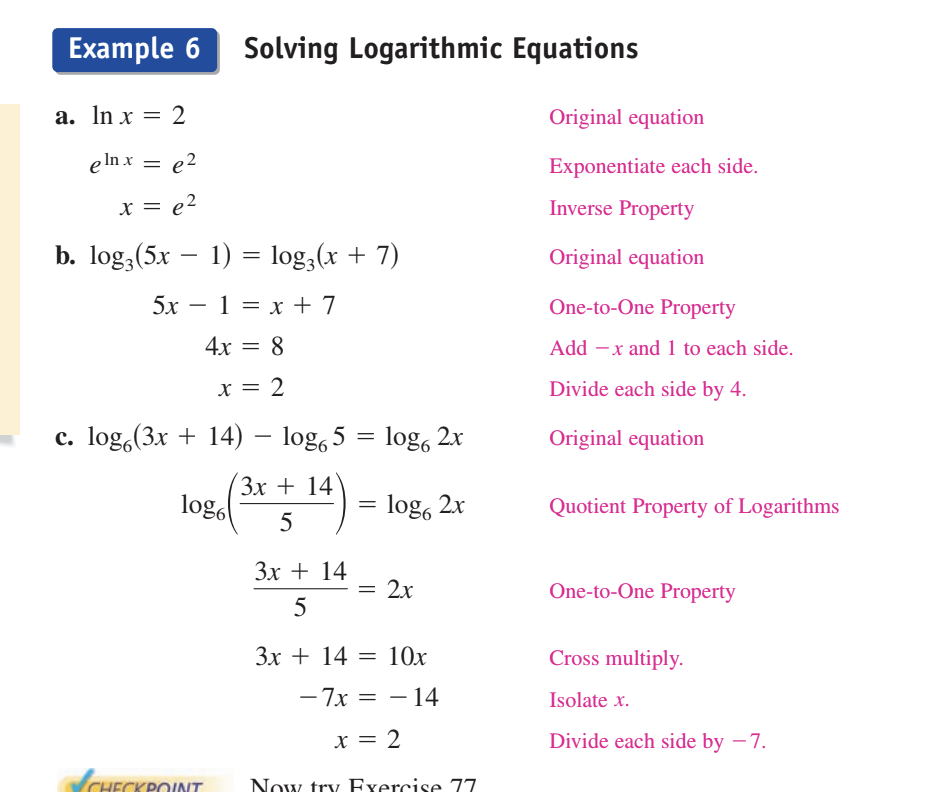
Ex 7 Solving a Logarithmic Equation

Ex 8 solving a Log equation
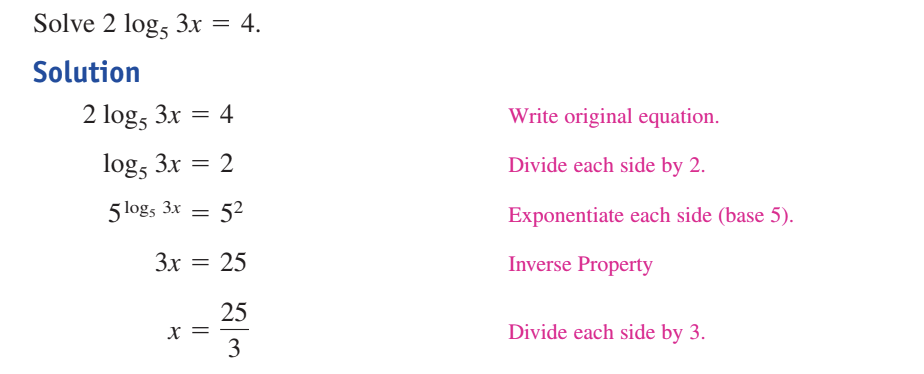
Checking for Extraneous Solutions
Because the domain of a logarithmic function generally does not include all
real numbers, you should be sure to check for extraneous solutions of logarithmic
equations.
An extraneous solution is a number that appears valid algebraically but does not satisfy the original equation, often because it makes a logarithm undefined.
Why It Happens:
Logarithms are only defined for positive arguments.
So if solving gives you an x that makes any log term ≤ 0, that solution must be rejected.
Steps to Check:
1⃣ Solve the equation normally (using log rules or exponentiating).
2⃣ Substitute each solution back into the original logarithmic expression.
3⃣ Reject any value that makes a log’s input ≤ 0.
Example:
log(x-2)+log(x+1)=log(3)
Solve x=2 and x=-1
check
x=-1 invalid because cannot have log(-3)
Ex 9 checking for extraneous solutions
